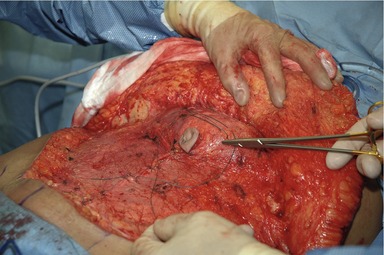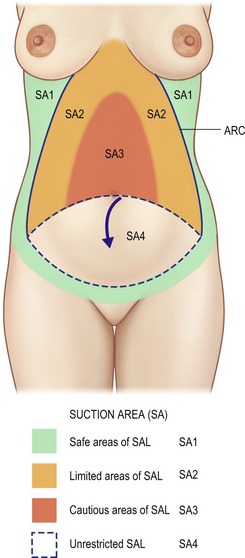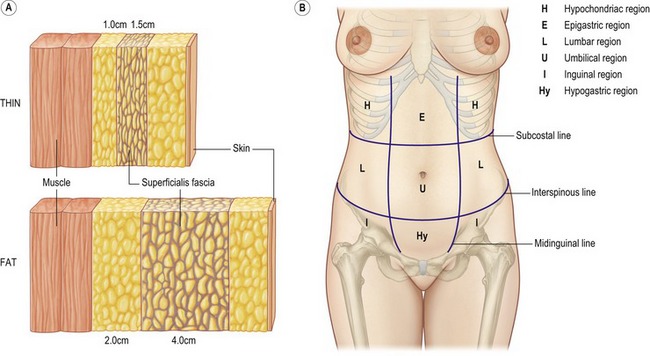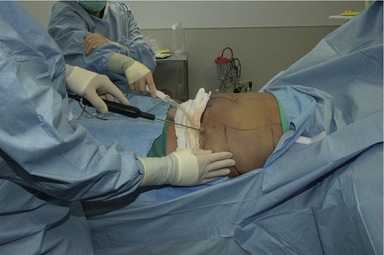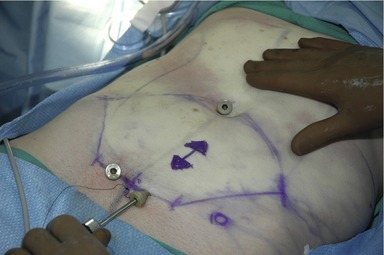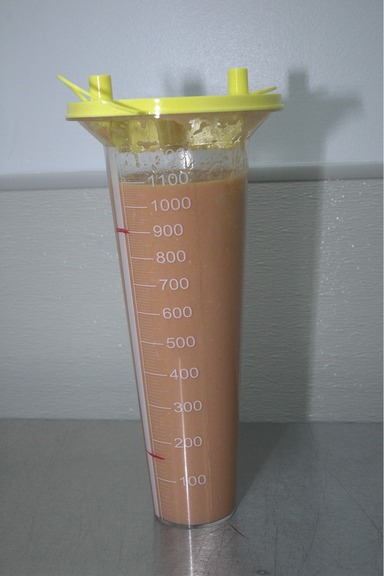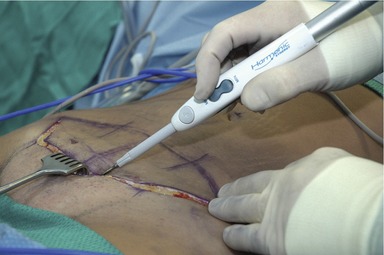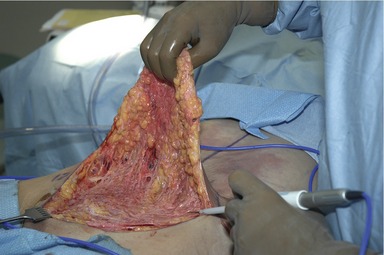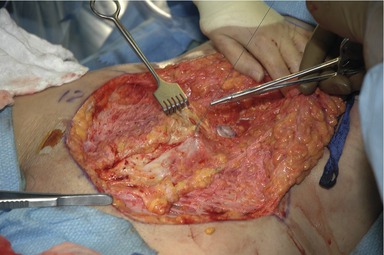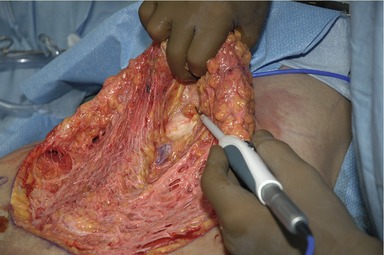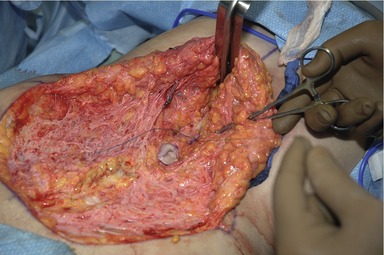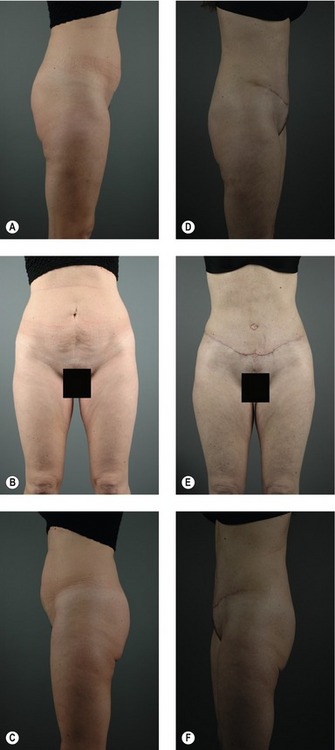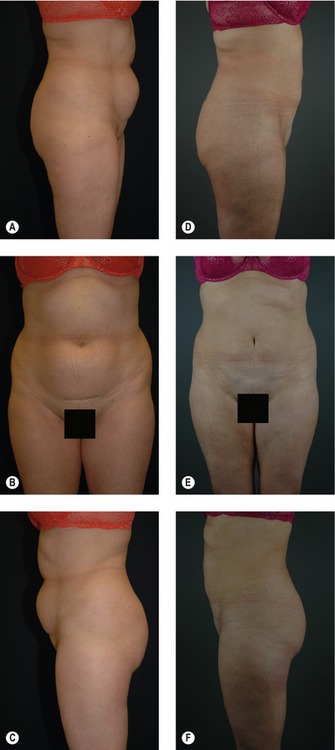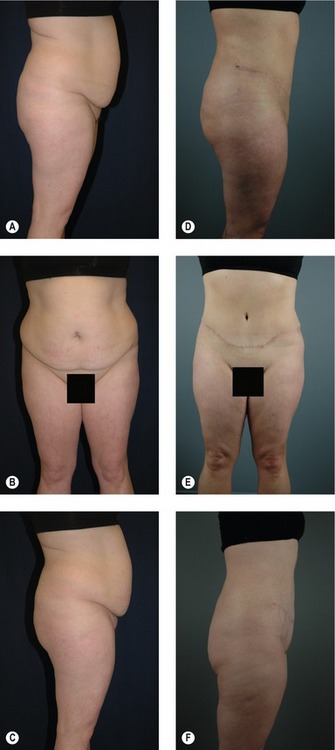CHAPTER 63 Lipoabdominoplasty: Advanced techniques and technologies
Introduction
The conventional or “classic” abdominoplasty is a technique that is dependent on delamination of the abdominal skin and adjacent layers (lamina) from the deep abdominal wall (rectus abdominis muscle) fascia in order to accomplish maximum tightening of loose tissues. In most cases, this is a safe procedure, with acceptable risk of delayed healing and scarring. For some patients who have undergone massive weight loss, the conventional abdominoplasty is necessary. (Fig. 63.1).
Safety concerns over combining lipoplasty and excisional surgery
For years, the matter of combining lipoplasty and the “classic” excisional abdominoplasty was met with skepticism and safety concerns regarding the combined effect of raising a devascularized flap of abdominal tissue that had been first traumatized by a lipoplasty procedure. The “red zone” influence of the diagrams contained within articles written by Matarasso (1989, 1991, 2000)1–3 greatly influenced our thinking about the potential for central abdominal skin necrosis when conventional lipoplasty was combined with classic abdominoplasty (Fig. 63.2).
Innovations in abdominoplasty
Progress on how to improve the quality of outcomes in abdominoplasty occurred when tension on the flaps was directed laterally to help shape the waist.4 Ted Lockwood in the early 1990s recognized the importance of the superficial fascia (Scarpa’s fascia) of the abdominal area to take tension off the skin closure.4,5 Avelar (1989) further refined the concept when he described a laminar approach to the abdominal wall, skin, subcutaneous fat, superficial fascia-fat matrix, and deeper fat layer6 (Fig. 63.3).
Other contributors to advanced concepts of abdominal contouring include Saldanha (2001), Shestak (1999) and Illouz (1992).7–10 The concept of safely combining lipoplasty with excisional surgery in order to improve the aesthetics of the entire abdominal region was demonstrated. Brazilian surgeons appear to have innovated the “lipoabdominoplasty”, although it is difficult to exactly credit one inventor, as several surgeons reported their own individual variations on the procedure. Matos and Ribeiro recently published an excellent review and classification of lipoabdominoplasty and its variants.11 Other surgeons, including Cardenas-Camarena and Brauman were some of the first to report lipoabdominoplasty in the American plastic surgery literature.12–13
VASER® ultrasonic lipoplasty combined with excision
When Dr Fodor, Dr Souza Pinto and I wrote the original VASER paper in 2002, I noted the capabilities of VASER® technology to deliver safe, effective, and precise outcomes that heretofore were not available with “conventional” lipoplasty or second-generation ultrasonic lipoplasty devices. The VASER® was able to safely treat all layers of tissue in areas such as the abdominal region and did not appear to inflict collateral damage to skin, vascular, lymphatics, or sensory nerves. It was possible to be selective for fat removal from the tissue matrix and still leave supporting structures largely intact, provided simple clinical guidelines were followed. The use of ultrasonic lipoplasty was initially reported by Abramson14,15 (Figs 63.4–63.6).
The effect of VASER® ultrasonic lipoplasty on the lamellae of the abdomen appears to go far beyond that of volume reduction, producing a “shrink wrap” effect on overlying tissue through a proposed tightening of the collagen rich mid-lamellar layer. Competing superficial technologies that utilize radiofrequency energy, infrared, or mechanical rollers lack a substantive effect at this depth. According to a prospective randomized study that compared conventional lipoplasty to the adjunct of laser energy delivered to the tissues done by Prado,16 there was not a substantive benefit noted.
Ultrasonic cutting devices
Additional innovation was made by Richter17 regarding how dissection above the superficial fascia could be performed to limit interruption of vascular and lymphatic structures where tissue excision is planned. Suture fixation of the superficial fascia to the deeper rectus fascia has been shown to stabilize the mons pubis and inguinal regions. Variations on this approach with resection of a midline strip of superficial fascia in the lower abdomen to access the deeper fascia for tightening have been reported by Jewell.18 Once the deeper tightening has been accomplished, the superficial fascia is closed with PDS suture (Ethicon Inc., Somerville, NJ USA). This approach works well with both procedures that require umbilical transposition or limited tissue excision from the lower abdominal region only.
Alternatives to electrosurgical dissection for tissue resection and creation of a central tunnel for tightening of the upper rectus muscle diastasis have been developed with the Ethicon EndoSurgery Synergy® ultrasonic scalpel Jewell19 and Richter17) (Fig. 63.7). This device allows for precise, rapid dissection above the level of the superficial fascia following the lipoplasty component of the procedure (Figs 63.8–63.10).
Upper abdominal dissection to expose the diastasis of the rectus abdominis is accomplished with the use of a fiberoptic retractor to provide upward traction. Hemostasis with this device is acceptable; it is possible to perform a lipoabdominoplasty without electrosurgery (Figs 63.11, 63.12).
Technical considerations for Ethicon EndoSurgery Synergy® ultrasonic scalpel in lipoabdominoplasty
1. Ultrasonic cutting devices function optimally when tissue has been infused with wetting solution.
2. Utilize a conventional scalpel to cut the skin, as ultrasonic cutting devices do not cut skin very effectively.
3. Ultrasonic scalpel cuts best when there is excellent bi-axial surgical traction on the wound. Utilize rakes or hooks to provide traction/counter traction.
4. The active (cutting) part of the ultrasonic scalpel is at its tip. It cuts best when sweeping motions across the wound are made.
5. Hemostasis with the ultrasonic scalpel is possible, but allow time for it to happen. Be proactive with hemostasis by using the coagulation mode on intact vessels. A perforator vessel that is cut and retracts back into the rectus abdominus sheath will be difficult to seal with either electrosurgical or ultrasonic devices.
6. Do not allow the ultrasonic scalpel when active to contact other surgical instruments, as it will crack the blade.
Steps for lipoabdominoplasty
Patient selection
The ideal patient for lipoabdominoplasty has:
2. Decreased abdominal wall tone.
3. Decreased abdominal skin tone.
4. Localized fat deposits to waist, upper/lower abdomen, mons pubis.
5. Absence of hernia other than umbilical.
6. Non-smoker, free of nicotine for 3 months.
8. Adequate support at home to help with recovery.
9. Limited interest in having concomitant procedures by other surgeons, i.e. hysterectomy.
Patient preparation for surgery
Lipoplasty component
1. Keep records of amounts of wetting solution infused, VASER® time, and amounts of lipoaspirate from each anatomic region.
2. Infiltrate wetting solution containing epinephrine 1 : 500,000:
3. 10-minute wait for epinephrine vasoconstriction to occur.
4. Fragment with all areas VASER® 3.7 mm probe 90% amplitude:
5. Aspirate with VENTX® cannula – 3.7 mm (preferred) or 4.6 mm:
Tissue resection
1. Make lower abdominal skin incision for standard abdominoplasty or limited approach with #10 scalpel.
2. Ethicon EndoSurgery Synergy® ultrasonic scalpel utilized to raise flap above the level of the superficial fascia (Scarpa) and achieve hemostasis.
3. Utilize rakes for bi-axial traction that permits excellent cutting with ultrasonic scalpel. Dissect with sweeping motion of ultrasonic scalpel.
4. Continue dissection up to level of umbilicus.
5. Circumscribe umbilicus and allow it to retract (standard abdominoplasty); work around or transect stalk if performing a limited procedure and you plan for upper abdominal tightening.
6. Create upper abdominal tunnel up to level of xiphoid with fiberoptic retractor. Leave perforator vessels intact.
7. Inspect all areas for hemostasis before resection of flap.
Resection of flap/abdominal wall tightening
1. Resect lower abdominal skin per usual technique. I try not to excessively flex table. Resection of lower abdominal tissue makes it much easier to tighten versus having assistant elevate skin when tightening abdominal wall.
2. Repair diastasis of upper rectus abdominus with figure of eight sutures, 2-0 Ethibond (Ethicon Inc. Somerville, NJ, USA).
3. Resect 5 cm wide strip of superficial fascia in midline from umbilicus down to lower incision margin with ultrasonic scalpel to expose deep fascia. Use rakes or clamps to provide traction.
4. Tighten lower abdominal fascia with 2-0 Ethibond – figure-of-eight sutures.
5. Repair superficial fascia with 2-0 PDS.
6. Anchor mons to deep fascia with 2-0 PDS to prevent movement.
7. Insert one or two perforated drains, 15 French size through mons skin.
Wound closure
1. Utilize towel clamps to approximate wound edges.
2. Close with high tension on lateral parts of incision – 2-0 PDS/3-0 Monocryl (Ethicon) – two-layer closure.
3. Mark umbilical location on skin.
4. Exteriorize and anchor umbilicus with 4-0 PDS.
5. Dermabond® (Ethicon) to complete closure.
6. Infuse 50 mL bupivicaine 0.25% w/epinephrine 1 : 200,000 through drain for postoperative pain control.
8. Lipoplasty silicone-backed foam/abdominal binder.
9. Discontinue Foley catheter.
10. Transfer to recovery bed, head of bed elevated, flex at knees.
11. If fragmented heparin is planned, start 6 hours after surgery.
Discussion
1. Matarasso A. Abdominolipoplasty. Clin Plast Surg. 1989;16(2):289–303.
2. Matarasso A. Abdominolipoplasty: a system of classification and treatment for combined abdominoplasty and suction-assisted lipectomy. Aesthet Plast Surg. 1991;15(2):111–121.
3. Matarasso A. Liposuction as an adjunct to a full abdominoplasty revisited. Plast Reconstr Surg. 2000;106(5):1197–1202.
4. Lockwood T. Superficial fascial system (SFS) of the trunk and extremities: A new concept. Plast Reconstr Surg. 1991;87(6):1009–1018.
5. Lockwood T. High-lateral-tension abdominoplasty with superficial fascial system suspension. Plast Reconstr Surg. 1995;1996(3):603–615.
6. Avelar J. Regional distribution and behavior of the subcutaneous tissue concerning selection and indication for liposuction. Aesthet Plast Surg. 1989;13(3):155–165.
7. Shestak KC. Marriage abdominoplasty expands the mini-abdominoplasty concept. Plast Reconstr Surg. 1999;103(3):1020–1031.
8. Illouz YG. A new safe and aesthetic approach to suction abdominoplasty. Aesthet Plast Surg. 1992;16(3):237–245.
9. Saldanha OR, De Souza Pinto EB, et al. Lipoabdominoplasty with selective and safe undermining. Aesthet Plast Surg. 2003;27(4):322–327.
10. Saldanha OR, de Souza Pinto EB, Matos WN, Lucon RL, Magalhães F, Lopez Bello ÉM. Lipoabdominoplasty without undermining. Aesthet Surg J. 2001;21(6):518–526.
11. Matos WN, Ribeiro RC, Marujo RA, da Rocha RP, da Silva Ribeiro SM, Carrillo Jiminez FV. Classification for indications of lipoabdominoplasty and its variations. Aesthet Surg J. 2006;26(4):417–431.
12. Cardenas-Camarena L, Gonzalez L. Large-volume liposuction and extensive abdominoplasty: A feasible alternative for improving body shape. Plast Reconstr Surg. 1998;102(5):1698–1707.
13. Brauman D. Liposuction abdominoplasty: An evolving concept. Plast Reconstr Surg. 2003;112(1):299–301.
14. Abramson D. Ultrasound-assisted abdominoplasty: Combining modalities in a safe and effective technique. Plast Reconstr Surg. 2003;112(3):898–902.
15. Rohrich RJ, Janis JE. Discussion, Ultrasound-assisted abdominoplasty: Combining modalities in a safe and effective technique. Plast Reconstr Surg. 2003;112(3):903–904.
16. Prado A, Andrades P, Danilla S, Leniz P, Castillo P, Gaete F. A prospective, randomized, double-blind, controlled clinical trial comparing laser-assisted lipoplasty with suction-assisted lipoplasty. Plast Reconstr Surg. 2006;118(4):1032–1045.
17. Richter D. Body contouring with ultrasonic scalpel, advantages and disadvantages. ASPS-PSEF Santa Fe Breast and Body Contouring Symposium, 2007.
18. Jewell M. Lipoabdominoplasty with Vaser ultrasonic lipoplasty and Harmonic scalpel. ISAPS Satellite Symposium, Melbourne, Australia, February 2008.
19. Jewell M. Precision in abdominal contouring: Achieving new contours. ASPS-PSEF Santa Fe Breast and Body Contouring Symposium 2007.

